An ultra sensitive pneumatic impact Hand
Engraving Tool for Engravers, Jewelers and Artists.
 The OMEGA, a larger version of the Air Chasing Graver will be
ready to ship soon. The OMEGA, a larger version of the Air Chasing Graver will be
ready to ship soon.
Designed and made by an
engraver/jeweler/toolmaker who has been building his own
engraving tools for 23 years. The Air Chasing Graver is a precision instrument,
designed for unsurpassed hand engraving and impact control.
A unique feature of the tool is the
lack of an internal spring found in other engraving impact tools. This lack of an
internal spring means a much wider power range (.05 PSI through 50 PSI).
Features:
Same size as a traditional palm push graverImpacts
per minute may be adjusted from 2,520 to an incredible 24,500
Length of stroke can be set from just a few
thousands to 3/8 of an inch
User-adjustable, three position comfort choice for tubing
attachment |
The recently released Air Chasing Graver is the
smallest and most customizable hand engraving impact tool available.
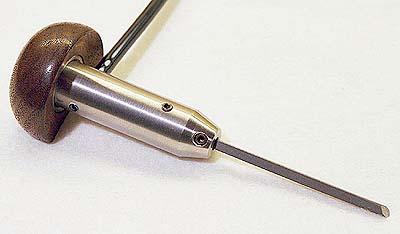 |
Stainless construction
Adjustable idle
Walnut handle with a Lindsay banknote style engraving inset
Hardened piston
Accepts gravers or points with shanks fitting a
.133"dia tool hole |
View computer videos of the Air
Chasing Graver at work, filmed through a microscope.
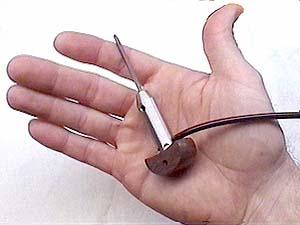 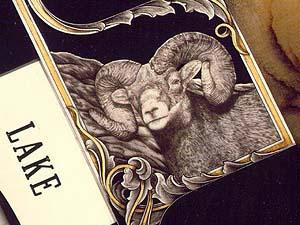
(Left) Air Chasing Graver. (Right)
1"x 3/4" steel engraving with gold inlays using the Air Chasing Graver. (click for close-up)
The Air Chasing Graver is the smallest hand
engraving impact tool on the market, ideally suited for fine exhibition grade
engraving. The tool is similar in size and feel to traditional non-powered hand
gravers.
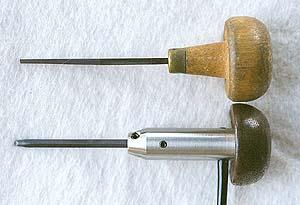
Air Chasing Graver pictured next to a traditional palm push graver.
The Air Chasing Graver will idle and oscillate with as little as 1/20th of
a pound of air (equivalent to the air pressure in a toy balloon), to provide the finest microscopic engraving shading
cuts. At the opposite extreme, the Air Chasing Graver can use up to 50 PSI, to
become a powerful metal cutting tool for deep engraving
projects, and to aid the jeweler or artist with hammering control. Length of stroke
and impacts per minute are fully adjustable via an adjusting mechanism in the handpiece.
Impacts per minute range from 2,520 to an incredible 24,500 (this is 20,500 impacts faster
than most other engraving impact tools). This allows the user to set up the tool in
accordance with his own unique preferences and to the type of engraving being
executed. Each one of these tools is produced by Steve Lindsay. They are not
mass produced but are made individually, with the personal attention to quality, materials
and fit that Steve Lindsay gives to all the tools he makes for his own engraving work.
| The Air Chasing Graver can also be used for stippling as
on this knife bolster. A point of needle sharpness is used, and the idle adjustment
set so that the tool is impacting continuously. The point is held loosely on the
surface of the work as the tool impacts. Many dots can be placed in a short time.
For the 24k gold inlay, the Air Chasing Graver was first used with a square graver to
outline the butterfly, and then a flat graver was used to cut out the pocket. Next
an onglette was used to under cut the pocket. Then, 24k gold sheet of .015"
thickness was cut out in the shape of the butterfly and a 1/8" round brass punch was
inserted into the Air Chasing Graver and used to hammer the gold into the pocket. (The
hammering expands the gold, forcing it into the undercuts in the pocket holding the gold
in place). The gold was then block sanded down flush, starting with 400 grit paper
and working up to 2000 grit. The final step was stipple engraving, carried out using
the Air Chasing Graver. See
more photos of the piece. |
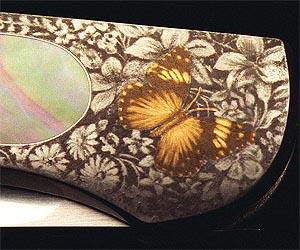 |
This hand engraving tool is operated and controlled with a
pressure regulator, foot control valve, needle valve, and a port adjustment
mechanism,contained in the handpiece, that controls length and speed of stroke.
Users supply an air compressor. Because the porting is well balanced, air
consumption is efficient. When the tool is idling or impacting delicately the tool
uses just .022 CFM (cubic feet per minute). To put this small amount into
perspective, it would take approximately ten minutes to fill a 10"x11" sized
plastic sack with air at this rate. Maximum air consumption can vary depending on
the porting adjustment set by the user in the handpiece. At 50 PSI, with the porting
adjustment set to a very fast, short length .020" stroke and with the foot control
pushed to the floor, the tool will require .4 CFM. With the porting adjustment set
to the maximum length of stroke of 3/8" the tool will require .875 CFM at the same 50
PSI. This low air consumption means only a small air compressor is required. A minimum of 30
PSI is recommended but 10 PSI is more than sufficient for fine engraving. Steve
Lindsay rarely uses over 15 PSI.
The Air Chasing Graver accepts 3/32" square gravers and 1/8"
round gravers or other gravers and points with a shank fitting the .133" dia. tool
hole. Three High Speed Steel gravers and one Carbide graver are included with the
tool.
No inexpensive aluminum is used in the Air Chasing Graver. The tool
features all stainless construction with a fine finished walnut handle, hardened piston,
adjustable idle, and customizable three
position choice for tubing attachment to the handpiece. Being equal in size to
the traditional non powered palm push graver, the Air Graver fits comfortably in the palm
of the hand. The inset in the butt of the handle is a Steve Lindsay banknote style
engraving designed for the handpiece and reproduced with a restored 1915 150 ton coining
press. The design was engraved in tool steel, hardened, and used to reproduced
itself in the press. Download and view a microscope
video of this actual die being engraved using the Lindsay Air Chasing Graver.
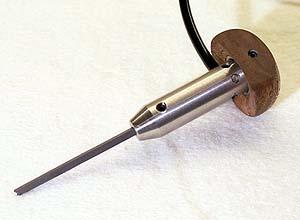 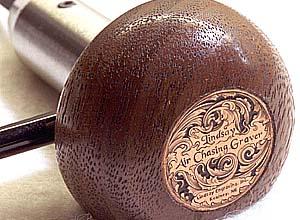
(Above left) Bottom view revealing a screw for the length and strokes per minute
adjustment. (Above right ) Inset banknote style engraving in handle.
 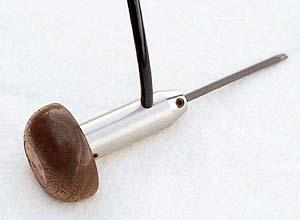
(Above) The tubing attachment may be moved to left rear, right rear or to front
center. Above, it has been moved to
front center. More info. and images of these attachment
options
User Feedback about the
Air Graver
Ordering Information
A note from Steve J. Lindsay
The evolution of the Air Chasing Graver began 23 years ago. In
1978 in college I majored in Tool & Die and Mechanical Engineering on the advice given
in 1975 by the late Bruce (James) Meeks, author of the book "Art of
Engraving". While there I made handpieces for myself and my father, Frank
Lindsay, to replace the one that came with a hand engraving machine my father purchased in
1972 from a co-inventor of that machine. In 1979 my father invented a fully adjustable
electronic circuit and valve that produced pulses of air. Other hand engraving
machines currently on the market today work on a similar air pulse principle but use a
mechanical rotary valve to produce the pulses. Both my father and I built numerous
handpieces for his electronic valve invention, until he perfected a miniature handpiece
that I have been using for most of my 21 years in the engraving profession. My
father talked about marketing his invention back then, but he decided not to - he wanted
to give me an edge over the competition in my engraving career.
I have found that the limitation to my father's design and other designs on the market is
that they depend on a spring for either the return or power stroke. The spring in
these designs creates a limited power band. They have an adverse effect of loss of
power, or a complete absence of power when the piston floats, caused by the air pulses
giving insufficient time for the spring to return. This is caused by the frequency
of the air pulses being too fast and/or by too much air pressure in each pulse. For
the past 6 years, I have been drawing, designing, and attempting to create a new device
that would give an even wider range of power and impact strokes, without sacrificing the
finesse and control my father built into his engraving machine. The venture led me
to research electronic solenoid engraving handpieces using 555 timer IC circuits.
These worked for the fine engraving, but did not have much power at the top end and also
produced too much heat. Then there are the drawers full of pneumatic devices and
handpieces including self-oscillating handpieces using a spring for either the return or
impact stroke. I found these designs had a limited power band, vibrated excessively,
and were hard to start without an extra surge of air pressure. Finally, by accident,
I happened on this design. The design I was attempting to build was a two valve
system working together as one in a forward direction, but I found the mechanism ran
better backwards. The challenging aspect was to create an impact device that would
pulsate with the softest whisper of air required for microscopic engraving shading work
and yet be able to muscle out the background around a scroll design when used with much
greater air pressure. This tool has been working well for my engraving and for a few
fellow engraver testers. As more of these tools get out into jewelers' and
engravers' hands I am looking forward to more feedback about
them.
Background and Advantage of the Air Chasing Graver
The traditional tool for hand engraving and stone setting - and one still widely used - is
the palm push graver tool. This traditional hand engraving tool consists of the
working point or graver, set into a wood handle that fits into the palm of the hand.
A problem that arises with this traditional tool, even in very fine
engraving cuts, is that when the graver is pushed through a cut, a loss of control is
experienced due to the force exerted. The graver point will tend to stick and slip
through the cut leaving an uneven incision. Even the best jewelers and engravers
have this problem when using a palm push engraver. Beginners will have even greater
difficulty, and in some cases the slipping can cause extensive damage to the work.
Engraving with a power impact engraving tool can eliminate this problem. No longer
do you need to "push", but let the impacts of the piston drive the tool through
the cut. In fact, while engraving with an impact tool you should not push at all,
but just hold the tool in the cut and concentrate on guiding or steering the graver.
Palm pushing, even with fine cuts, will still result in the sticking and
slipping problem. An advantage of Frank Lindsay's machine, and now the Air Chasing
Graver, is using power for the finest cuts rather than palm pushing. Even when
shading fine lines in something as soft as 24k gold, ivory or pearl, the use of power will
result in more control and confidence than palm pushing. For example, the pearl in this and this
knife handle, were engraved with the Air Chasing Graver set for extremely fine
impacts. Pearl is similar to the consistency and hardness of a fingernail and is
easily cut by palm pushing but, because the sticking and slipping problem can leave an
uneven cut even in soft materials, the handpiece was set up to give short, delicate
impacts by adjusting the speed and length of stroke mechanism within the Air Chasing
Graver. To help the foot pedal control give a full range of movement, the regulator
air supply is lowered 2.5 to 3 PSI. See the engraving tutorial page for
more about this.

User Feedback about the Air Graver
View a microscope video of the Air Chasing
Graver at work.
Ordering Information
 The OMEGA, a
larger version of the Air Chasing Graver will be ready to ship soon. The OMEGA, a
larger version of the Air Chasing Graver will be ready to ship soon.

Email: slindsay@lindsayengraving.com
Web: www.lindsayengraving.com
|